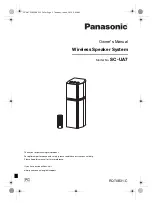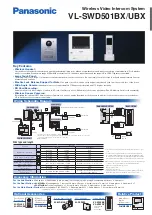
RQT9219
18
ENGLISH
ESP
AÑOL
Connections
Connect to a receiver or amplifier
with 6-
Ω
impedance for the front
and surround speakers, and a pin-type output terminal for an active
subwoofer. You cannot connect these speakers to any equipment
other than this amplifier.
Before connection
Turn off the other equipment.
Do not connect the AC mains lead until all other cables and cords
are connected.
Front and surround speakers
With the front speakers
and
, connect their center speaker cables
(approx. 6 meters) to the center terminals on the amplifier, and
connect the speaker cables
(short: 6 meters) to the front terminals.
With the surround speakers
and
, connect the speaker cables
(long: 10 meters) to the surround terminals.
Be sure to connect the (+) ends of the speaker cables to the positive
(+) terminals of the amplifier and connect their (–) ends to its negative
(–) terminals.
Never short-circuit positive (+) and negative (–) speaker wires.
Subwoofer
1. Connect using the included monaural connection
cable
to the receiver or amplifier’s subwoofer
output terminal.
For the United Kingdom:
BE SURE TO READ THE CAUTION FOR THE AC
MAINS LEAD ON PAGE 3 BEFORE CONNECTION.
2. Connect the AC mains lead
to the household
AC outlet
.
The included AC mains lead is for use with this unit only.
Do not use it with other equipment.
Bi-wiring connections
The front speakers come with separate mid/high-range (HF) and low-
range (LF) terminals. If your amplifier comes with two sets of speaker
terminals marked A and B, for instance, you can enjoy a more expan-
sive sound field and a greater depth in the sound by connecting the
speaker terminals to the terminals A and B on the amplifier.
• Remove the shorting bars
(but be sure to keep them in a safe
place).
• Use the speaker cables
(not provided) to connect both the HF
and LF terminals on the amplifier to the front speakers.
• Set the speaker selector switch on the amplifier to A/B (both A and
B).
(For further details, refer to the operating instructions of the ampli-
fier.)
Note
• Do not move the speaker while the speaker cables are connected.
This may cause a short circuit.
• Make sure to bundle the speaker cable with a string etc. when re-
locating the speaker cables.
Conexiones
Haga las conexiones a un receptor o amplificador
con impedancia de 6-
Ω
para los altavoces delanteros y de sonido ambiental, y emplee un terminal de
salida tipo contactos para un altavoz de subgraves activo. No puede conectar
estos altavoces a ningún otro equipo que no sea este amplificador.
Antes de hacer la conexión
Apague el otro equipo.
No conecte el cable de alimentación de CA hasta después de haber
conectado todos los demás cables.
Altavoces delanteros y de sonido
ambiental
Con los altavoces delanteros
y
, conecte los cables de sus al-
tavoces centrales
(6 metros aproximadamente) en los terminales
de altavoces centrales del amplificador, y conecte los cables de los
altavoces
(cortos: 6 metros) a los terminales de los altavoces
delanteros. Con los altavoces de sonido ambiental
y
, conecte
los cables de los altavoces
(largos: 10 metros) a los terminales de
altavoces de sonido ambiental.
Asegúrese de conectar los extremos (+) de los cables de los altavoces
a los terminales positivos (+) del amplificador y los extremos (–) a los
terminales negativos (–).
No cortocircuite nunca los cables positivos (+) y negativos (–) de
los altavoces.
Altavoz de subgraves
1. Conéctelo con el cable de conexión monofónico
suministrado
al terminal de salida de altavoz
de subgraves del receptor o amplificador.
2. Conecte el cable de alimentación de CA
a la
toma de CA del hogar
.
El cable de alimentación de CA suministrado es para ser utilizado
con esta unidad solamente.
No lo utilice con otros aparatos.
Conexiones tipo bicableado
Los altavoces delanteros vienen con terminales separados de gama media/alta
(HF) y de gama baja (LF). Si sus amplificadores vienen con dos juegos de
terminales de altavoces marcados A y B, por ejemplo, usted puede disfrutar de
un campo acústico más expansivo y de una mayor profundidad en el sonido co-
nectando los terminales de altavoces a los terminales A y B del amplificador.
• Quite las barras de cortocircuito
(pero asegúrese de guardarlas
en un lugar seguro).
• Use los cables de altavoces
(no suministrados) para conectar los
terminales HF y LF del amplificador a los altavoces delanteros.
• Ponga el selector de altavoces del amplificador en A/B (ambos, A y B).
(Para conocer más detalles, consulte las instrucciones de funciona-
miento del amplificador.)
Nota
• No mueva el altavoz mientras están conectados sus cables. Esto
podría causar un cortocircuito.
• Asegúrese de juntar los cables de los altavoces con una cuerda,
etc. cuando cambie la posición de los mismos.
Содержание SBTP1000 - SYSTEM -MULTI LANG
Страница 65: ...RQT9219 65 РУССКИЙ ЯЗЫК ...
Страница 66: ...RQT9219 66 ...
Страница 67: ...RQT9219 67 ...
















































